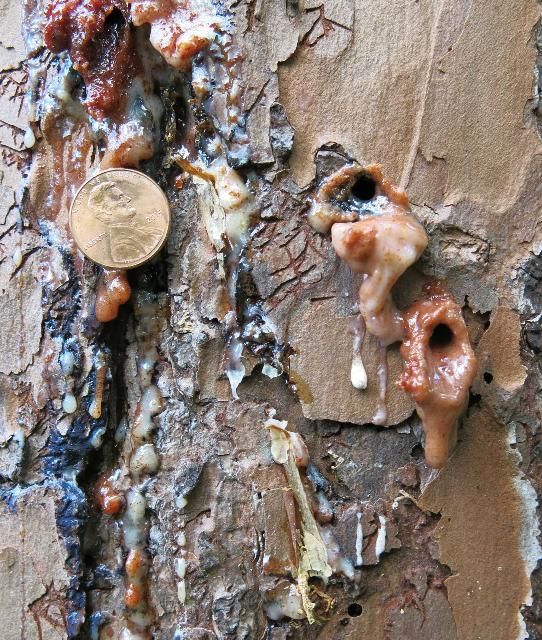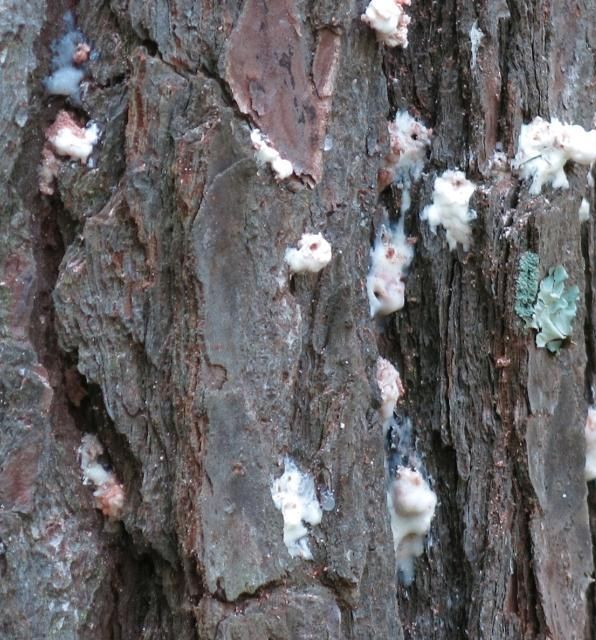This guide is intended to help tree owners and Extension personnel make decisions about pine trees that display signs of attack by wood borers. The information presented here pertains only to Florida and the adjacent southeastern region. Other regions may have different pines and different tree pests. The guide pertains mostly to pines grown on a non-industrial scale, such as in private backyards. Large acreages may require more stringent diagnostics. Note that there are many sources of pine stress other than insects; for complete advice, please contact your county Extension agent or post your question at the Tree Health Diagnostics Forum run by the University of Florida and the Florida Forest Service: https://www.facebook.com/groups/SouthernTreeHealthDiagnostics.
The Problem
Bark beetles are among the most common insects seen on dead pines in Florida. Their presence on the dead or dying trees are associated with obvious signs, such as abundant sawdust or the oozing of resin. Because the injuries are so evident, bark beetle infestations are frequently reported. Most frequently, however, bark beetle presence in a pine is a symptom of previous stress or injury, not the cause of death. Every dead pine tree in Florida will attract bark beetles, just like roadkill attracts vultures. But in only very few special situations are bark beetles the cause of the tree death. This publication aims to help the homeowner distinguish those special circumstances from the much more common situation when beetles are secondary.
Landowners often ask for assistance with this issue: "Something is attacking my pine. What should I spray it with?" The answer to this question is threefold:
- First, make sure the tree has actually been attacked by bark beetles. There are many causes for declining pine health. Partial needle loss or color change is common—it may not be caused by bark beetles and may not even indicate a health problem. If the whole tree is changing color rapidly, however, and especially if fresh resin blobs appear on the tree trunk, you need to act quickly and get a reliable diagnosis. Anytime you are unsure, contact a tree health professional, or our team at https://www.facebook.com/groups/SouthernTreeHealthDiagnostics.
- Next, make sure it is not already too late. If you can clearly see that a pine is being colonized by bark beetles, it may as well be already dead. Pine trees are not like oaks. Oaks and many other broadleaf trees can regenerate from even a bad disease or stress, but pines typically cannot. Once on the path to death, there is no recovery for a pine tree. But you can protect the pines around! Even if you can't save this pine, you can determine the cause of death using this document and see if you can prevent other nearby pine trees from dying.
- Finally, realize that spraying a dying pine with an insecticide doesn't work. You will not be able to reverse the course of tree death. Once your pine tree is suffering so much that it appears dying, your best option is to simply remove it and replace it. Insecticides or fungicides will not help it recover. You can see more about this issue in our short Extension video: https://www.youtube.com/watch?v=xm5OY2fsD7Q.
Is Your Pine Attacked by Bark Beetles? Look Closely at the Bark
- The pine seems to be declining, but the bark has no beetle symptoms (no dust, no holes). When you peel off a tiny piece, the tissue is yellow and wet (healthy)—Not bark beetles.
- The bark has occasional holes, but no resin flow. The holes do not penetrate the tissue under the bark; that wood is yellow and wet (healthy)—Bark-boring insects, no concern.
- The bark is producing dry brown or white sawdust, also known as frass. There are tunnels under the bark: Non-epidemic bark beetles. Your pine is definitely dying; however, there is low likelihood of these beetles spreading to the neighboring pines. To see whether you need to take further action, see the following section.

Credit: Jiri Hulcr
- Resin is coming out of the bark on many places. This resin can have different colors or shapes. There are tunnels under the bark. You may have bark beetles.
The Presence of Non-Epidemic Bark Beetles Means That Your Pine Is Dying
Non-epidemic bark beetles attack pines that are stressed. These are mostly the Ips pine engravers, the black turpentine beetle, or one of a few other species of wood borers. Non-epidemic bark beetles do not spread to neighboring pines, and no further action is needed. However, the beetles may multiply quite a lot, and sometimes you may want to protect the neighboring trees if they are a little stressed. Here we will determine whether you should remove the attacked tree:
- The attacked pine is rather solitary, there are not many other pines nearby, or all the other pines are less than 10 years old—removal not necessary,
- There are other mature pines just next to the attacked tree. It is fall or winter: the beetles are unlikely to emerge—removal not necessary, though recommended later.
- There are other mature pines just next to the attacked tree. It is spring or summer, so the beetles will be able to emerge—remove the attacked tree soon.
You May Have "Epidemic" Bark Beetles
Epidemic bark beetle species are capable of multiplying fast and killing adjacent pines. The only truly epidemic species in Florida is the southern pine beetle. But it is actually rare, and similar symptoms may be caused by the black turpentine beetle and the Ips beetle, both of which are more common and less dangerous than the southern pine beetle. See the next section, "Distinguishing Dangerous Bark Beetles."
Distinguishing Dangerous Bark Beetles
The Black Turpentine Beetle
The resin flows only from spots at the base of the tree (rarely above 8 ft). The flow is conspicuous (>1 in). This is the black turpentine beetle, a species that is rarely epidemic: removal recommended, but not urgent. Monitoring of surrounding trees is critical. This is the one case when an insecticidal spray may help, if applied preventatively to the base of the neighboring trees.

Credit: Jiri Hulcr
The lps Beetle
Resin flows from many sources all along the trunk. Peel off the bark (use a hatchet). If you see two types of tunnels—larger straight vertical ones and many smaller curved ones, they were made by the non-epidemic Ips beetles that happened to attack a still living but certainly stressed pine. Ips beetles rarely mount an outbreak, and never in a healthy, thinned stand. Removal is usually not necessary, but also go back to "The Presence of Non-Epidemic Bark Beetles Means That Your Pine Is Dying."

Credit: William M. Ciesla
The Southern Pine Beetle (SPB)
Resin emerges from many sources all along the trunk, dozens or hundreds. It appears less like a flow of resin and more like popcorn-shaped white balls of resin. Importantly, most of the resin balls are in the crevices between bark flakes, not on top of the flakes. Peel off the bark: with SPB, all the tunnels will be curved and winding. This is the only pine bark beetle in the Southeast that can cause an epidemic. If you discover these symptoms, and if you live north of Orlando, remove the tree immediately. Depending on the stage of the colonization, you may also need to remove the neighboring trees. Please refer to https://edis.ifas.ufl.edu/in333, the UF/IFAS publication about the southern pine beetle, for more guidance.

Credit: J. Eickwort, Florida Forest Service

Credit: Jiri Hulcr

Credit: Jiri Hulcr
Additional Considerations
Use Different Management Strategies for Different Settings
Note that pest management in backyards and small pine groves may differ from management in pine plantations. In residential areas, we recommend a more active suppression than in plantations. In plantations, owners should wait and watch, and only if the rate of infestation exceeds their tolerance for economic losses, should they treat the affected areas by a clear-cut. Suppression of an outbreak in a plantation often requires heavy machinery, which may lead to further stress of the non-attacked trees. Suppression is usually less invasive in small settings.
Note the Time Since the Attack
If you have determined that your pine tree was colonized by bark beetles that may cause harm to additional trees around, you may need to remove it. However, the urgency of removal is very much dependent on the length of time that has elapsed since the attack.
Combine the bark symptoms with your observation of the tree crown. What do the needles look like?
Needles are green and appear healthy, even though the bark has been colonized by beetles, and the new generation is hatching (Figure 7). Remove immediately!

Credit:
Needles are red; red needles indicate advanced colonization of the tree. A new generation of beetles has probably already hatched (Figure 8)! Remove immediately! Also, take a look at the neighboring trees. Do you see any resin? That may be an indication of new attacks.

Credit:
Needles are gray, dead and drooping. The colonization is over. The aggressive beetles are gone, and what's left are their predators and parasites (Figure 9). You can leave the tree on site. (Unless it presents a hazard, for instance, because it may fall on a structure.) Long-dead trees are your friends! They sustain natural enemies of bark beetles. More information about why and how we should leave dead trees in our urban landscapes is in this Ask IFAS publication: https://edis.ifas.ufl.edu/publication/FR482.
Make sure you check neighboring trees for attacks!

Credit:
Additional Information
More information on these insects can be found in Ask IFAS publications https://edis.ifas.ufl.edu/in701 (Ips engraver beetles), https://edis.ifas.ufl.edu/in636 (black turpentine beetle) and https://edis.ifas.ufl.edu/in333 (southern pine beetle). For information about Florida's SPB prevention program, see http://www.freshfromflorida.com/Divisions-Offices/Florida-Forest-Service.
Table 1.